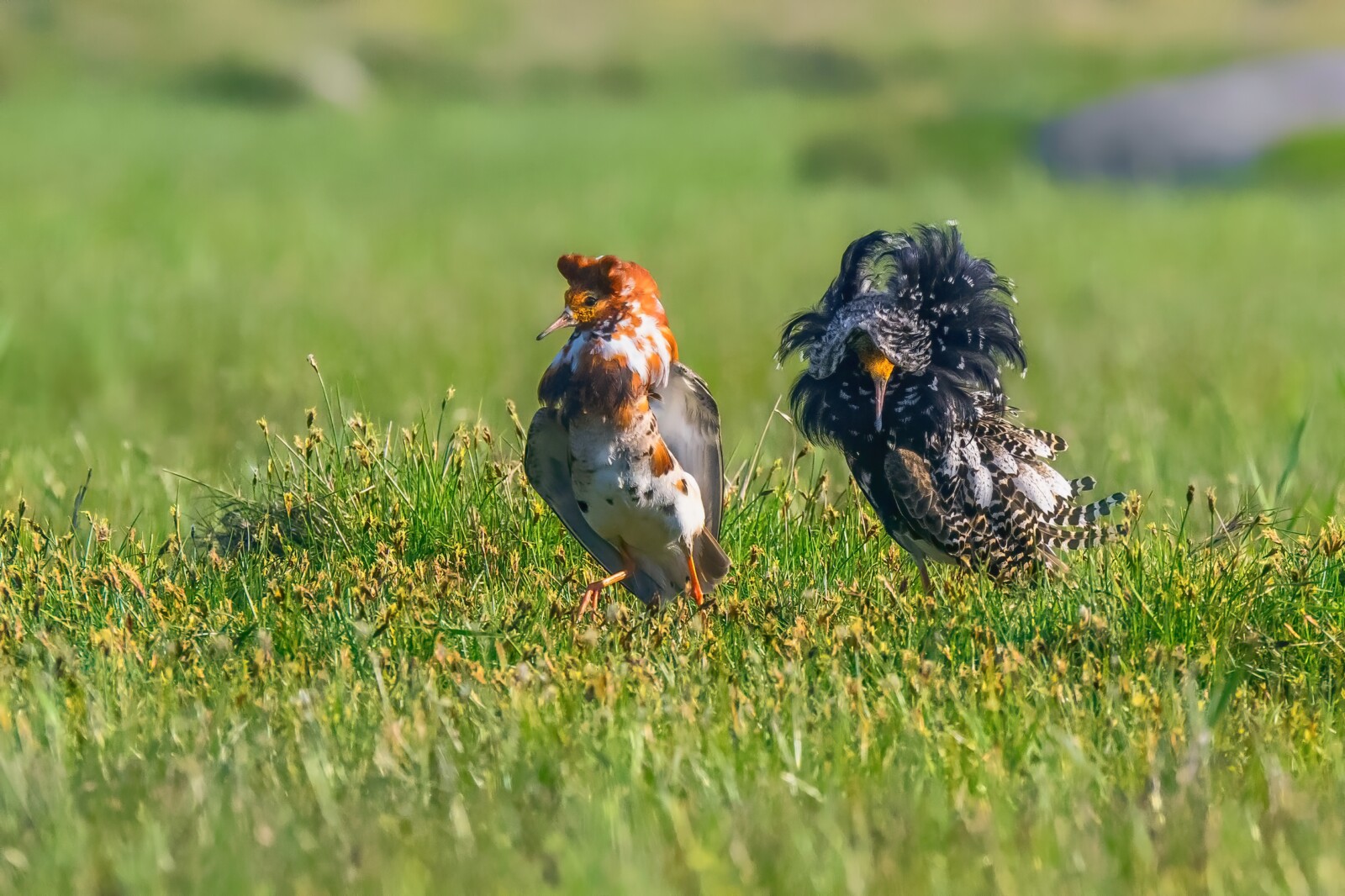Ruff
Ruff. Photo: Peter Lind
Introduction
Latin Philomachus pugnax (L.)
Estonian Tutkas
Also known as: no known names
Status in Estonia
Breeding and migratory bird.
Description
The ruff is a bird with a small head and strong body, a long neck and a medium-length beak pointing downwards. Male birds are much larger and heavier than female birds. The back feathers on the top are fluffy and frequently puff up when looking for food or in the strong wind, like a fluffy brush. A narrow light stripe on the wing, with huge white oval spots on the upper part of the base of the tail. The colour of the beak and legs varies, with an extensive pattern on the top side. The male bird in definitive plumage has a fluffy tuft and a neck ruff that come in various colours and variants; they might be black, red-brown, orange or white, single-toned or widely streaked and occur only in May and June. The beak, bare facial skin and legs are typically orange. The female bird is brown with various spots; the beak is mostly black, but the legs are orange or dull red. Adult birds are identical in winter, with the exception of size.
Size
Male body length 29–32 cm, female body length 22–26 cm. Male wingspan 54–60 cm, female wingspan 46–49 cm. Male body mass 168–242 g, female body mass 85–126 g.
Similar species
Common redshank.
Distribution
The ruff is a migratory bird that breeds in the Eurasian tundra and temperate zones and winters in West, East and South Africa, Southeast and South Asia and, to a lesser extent, Western and Southern Europe. It is an unevenly distributed breeding bird in Estonia. The birds nesting in Estonia are from the same population that winters in West Africa.
Population
Estonia has 10–30 breeding pairs.
Occurrence in Estonia
It arrives during the second half of April. The massive migration occurs in early May. Autumn migration begins at the end of July, with the final individuals leaving our area in September.
Diet
Insects and other invertebrates make up the majority of the diet, with some plant parts being consumed in the winter.
Habitat
It breeds in a variety of open landscapes, including tundras, floodplains and beach meadows and bogs. In Estonia, it is predominantly a bird of wet meadows that will freely inhabit flood-meadows and fens. It nests less frequently in pastures where large areas are covered with tussocks or trampled. The nest is surrounded by wetlands with minimal vegetation, where the birds and their young can feed later.
Nesting
From the start of spring until the middle of June, male birds roam around and engage in strange battles and fights on higher mounds or on the sides of ditches. During this time, they don’t participate in nest building and mate with every female bird they encounter. It is not until the end of June that the male birds begin to ‘calm down’ and they also begin to lose their distinctive nuptial plumage. However, by then, the first chicks have already learned to fly.
The female bird looks for a nesting site and builds a nest, which is a hollow in the ground lined with straw and usually camouflaged by grass or dry grass. In the second half of May, the female bird lays four eggs with a greenish or brown shell and dark brown markings, which she incubates for 20–23 days. The chicks become capable of flight 25–28 days after hatching, after which the female bird also begins to moult. Flocks form shortly after that and the autumn flocking life continues until they depart.
Conservation status and protection
It belongs to the protected species of category I. The European population is threatened by the loss of habitats, the intensification of agriculture and the non-use or inappropriate management of semi-natural grasslands. Falcons and mustelids are the primary natural enemies, particularly for male birds who frequently forget their surroundings while fighting and then end up becoming easy prey for a predator.
Distribution and population in Lääne County
The ruff is a common migratory bird on the coast of Lääne County. Few ruffs nest in Matsalu’s flood-meadows and beach meadows.
The ideal time to see ruffs is between the end of April and the beginning of May, when hundreds of ruffs gather on the beach meadows of Matsalu National Park and Silma Nature Reserve. In Matsalu, the best spots to see the ruff are Haeska and Tahu beach meadow in Noarootsi.
